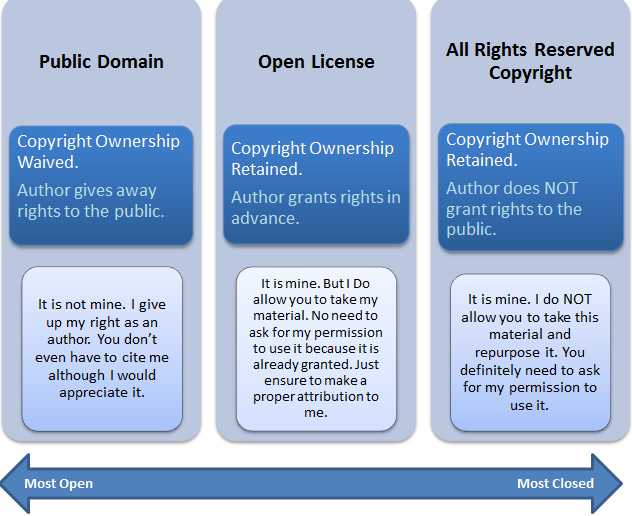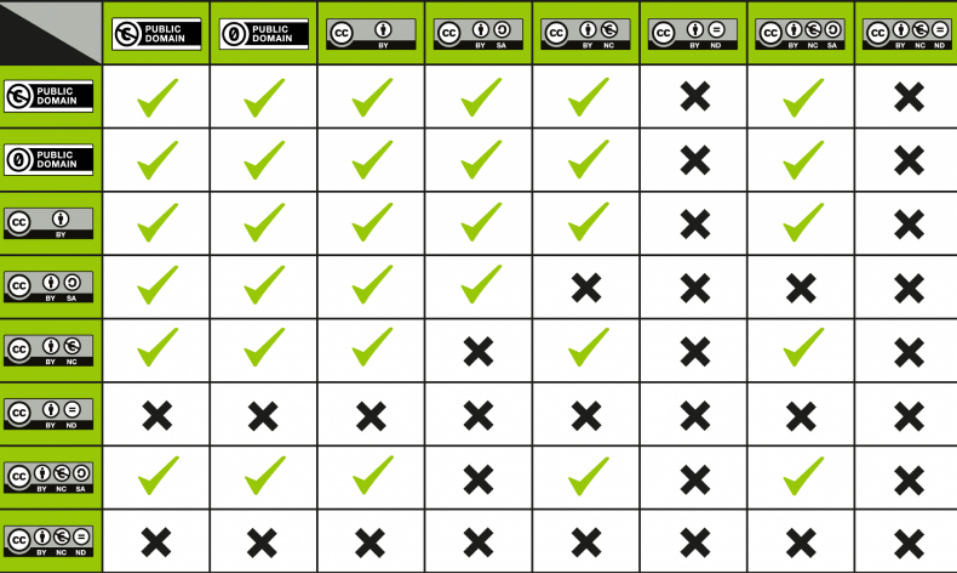
Copyright
Copyright is a form of legal protection automatically provided to the authors of “original works of authorship,” including literary, dramatic, musical, and artistic works. Copyright in the U.S. is automatically assigned to creators of work, with no registration necessary. It can be unlawful to use copyrighted works of others without their permission. Violation is called copyright infringement.
A public domain work is a creative work that is not protected by copyright, which means it’s free for you to use without permission. Works in the public domain are those for which intellectual property rights have expired, have been forfeited, or are inapplicable.
An open educational resource is either in the public domain or released with copyright permissions which allows for free use and re-purposing by others. Specifically, an open license exists as a way for the original creator to clearly inform others how their work can be used by granting permissions to share and adapt their work. A Public Domain license and the variety of open license permissions known as Creative Commons (CC) are the predominant standards for open licenses.
The four Creative Commons (CC) conditions can be combined in different ways to create six different CC licenses that are useful combinations of conditions, all including the primary condition of Attribution. Understanding the meaning of each condition can be useful when deciding which CC license to use on your own work.
Four Creative Commons Conditions

The Attribution (BY) condition is fundamental to all CC licenses. What many creators care about most is receiving credit for their creative work. When reusing CC-licensed work, proper attribution must be given to the original creator — and to other contributors on the work, if any. The CC BY license is the most open of all the licenses and allows for the most re-use.

The Share-Alike condition adds a requirement for anyone reusing your work to also license their own creation (based on your work) under the same license. Both the CC BY-SA and CC BY-NC-SA licenses include this condition, effectively making them ‘copyleft’ or ‘viral’ licenses. While this condition effectively “locks open” the content, remixing SA content with non-SA or other-SA licensed work may not be straightforward or allowed at all.

The Non-Commercial condition allows for reuse and sharing but reserves commercial rights for the creator. The meaning of the NC condition itself and its ability to prevent commercial reuse is not always clear, but the license condition does clearly indicate that commercial reuse rights are not being granted.

The No-Derivatives condition allows sharing and reuse but only if the content is left unchanged. This presents an issue when searching for OER, as no customization or adaptation is allowed by the license. For this reason, ND content is not considered OER and should be considered for reuse only in situations where no adaptations are needed.
Six Creative Commons Licenses

This license lets others distribute, remix, tweak, and build upon your work, even commercially, as long as they credit you for the original creation. This is the most accommodating of licenses offered. Recommended for maximum dissemination and use of licensed materials.
BY: Credit must be given to the creator.
View License Deed | View Legal Code

This license lets others remix, tweak, and build upon your work even for commercial purposes, as long as they credit you and license their new creations under the identical terms. This license is often compared to “copyleft” free and open source software licenses. All new works based on yours will carry the same license, so any derivatives will also allow commercial use. This is the license used by Wikipedia, and is recommended for materials that would benefit from incorporating content from Wikipedia and similarly licensed projects.
BY: Credit must be given to the creator.
SA: Adaptations must be shared under the same terms.

This license allows for redistribution, commercial and non-commercial, as long as it is passed along unchanged and in whole, with credit to you.
BY: Credit must be given to the creator.
ND: No derivatives or adaptations of the work are permitted.

This license lets others remix, tweak, and build upon your work non-commercially, and although their new works must also acknowledge you and be non-commercial, they don’t have to license their derivative works on the same terms.
BY: Credit must be given to the creator.
NC: Only noncommercial uses of the work are permitted.

This license lets others remix, tweak, and build upon your work non-commercially, as long as they credit you and license their new creations under the identical terms.
BY: Credit must be given to the creator.
NC: Only noncommercial uses of the work are permitted.
SA: Adaptations must be shared under the same terms.

This license is the most restrictive of our six main licenses, only allowing others to download your works and share them with others as long as they credit you, but they can’t change them in any way or use them commercially.
BY: Credit must be given to the creator.
NC: Only noncommercial uses of the work are permitted.
ND: No derivatives or adaptations of the work are permitted.
Not all creative commons licenses are compatible with each other. Use the chart below to see what ones are compatible.

For more information on Creative Commons, the 5R’s and OER check out the presentation by David Wiley

